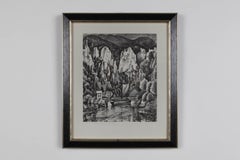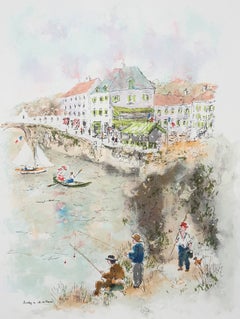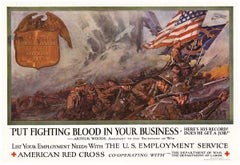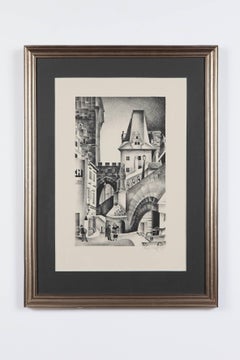Karl Holtz Landscape Prints
to
1
Overall Width
to
Overall Height
to
2
376
169
157
147
1
1
1
1
1
1
Artist: Karl Holtz
Karl Holtz Lithograph "Flusslandschaft" ( River Landscape )
By Karl Holtz
Located in Berlin, DE
Lithograph on wove paper, 1920s by Karl Holtz ( Germany ). The unsigned lithograph is probably a later, possibly posthumous print. Black and white gold frame...
Category
Early 20th Century Karl Holtz Landscape Prints
Materials
Lithograph
Related Items
Sunday in the Isle de France /// Contemporary City Street Scene River People Art
By Urbain Huchet
Located in Saint Augustine, FL
Artist: Urbain Huchet (French, 1930-2014)
Title: "Sunday in the Isle de France"
*Signed by Huchet in pencil lower right
Year: 1985
Medium: Original Lithograph on unbranded white wove paper
Limited edition: 350, (the number may differ from what is shown in the photos)
Printer: Unknown, Paris or Cannes, France
Publisher: the artist Huchet himself, Paris or Cannes, France
Sheet size: 30" x 22"
Image size: 27" x 20.5"
Condition: Never framed, has been professionally stored away for decades. In mint condition
Notes:
Numbered by Huchet in pencil lower left. The title printed in the plate lower left.
Biography:
Born in Rennes on April 28, 1930. After studying law and owning a textile factory for four years, he decided in 1960 to devote himself entirely to painting. He does many paintings of landscapes and the typical people of his region. His love of the Brittany coast and the sea can always be seen in his work. After moving to Paris in 1963, his love of adventure and travel led him to spend more time painting and writing in Europe, the Middle East, and South America, where he produced many paintings of the Indian markets and the great scenery. He made 14 trips, each of more than 4 months each, from Mexico to Brazil via Peru, Central America and the Caribbean Islands. In Addition to the paintings, he has written a book about these beautiful countries. A luxurious portfolio of paintings of Egypt...
Category
1980s Contemporary Karl Holtz Landscape Prints
Materials
Lithograph
Put Fighting Blood in Your Business
Located in Spokane, WA
Original WW1 poster. Put Fighting Blood in Your Business. Here’s his record! Does he get a Job? Arthur Woods, Assistant to the Secretary of...
Category
1910s American Realist Karl Holtz Landscape Prints
Materials
Lithograph
Glance of a Landscape-Poster, New York Graphic Society. Printed by U.S.A.
By Paul Klee
Located in Clinton Township, MI
New York Graphic Society, Ltd. Printed by U.S.A. Measures 15 x 20 inches and is unframed. The piece is in Good Condition.
Category
1970s Karl Holtz Landscape Prints
Materials
Lithograph
Remember the Sabbath Day (The Fourth Commandment)
By April Gornik
Located in New York, NY
April Gornik
Remember the Sabbath Day (The Fourth Commandment), 1987
2 Color Lithograph on Dieu Donne handmade paper with deckled edges
24 × 18 inches
Signed and numbered AP 12/15, a...
Category
1980s Naturalistic Karl Holtz Landscape Prints
Materials
Lithograph, Pencil, Graphite
"The Putting Green" - Figurative Landscape
By Douglas Adams
Located in Soquel, CA
"The Putting Green" - Figurative Landscape
20th century lithograph copy (restrike) of an original painting by British artist Douglas Adams (English, 185...
Category
1970s Realist Karl Holtz Landscape Prints
Materials
Lithograph, Paper
Landscape - Original Lithograph by Giovanni Omiccioli - 1971
By Giovanni Omiccioli
Located in Roma, IT
Landscape is a beautiful original lithograph on cardboard, realized by the Italian artist Giovanni Omiccioli (Rome, 1901-1975) in 1971.
Signed and dated in pencil, on the lower margin.
In very good conditions, except for some minor holes on edges, the colors are incredibly bright.
Numbered on the lower left margin, 88/90 prints.
Giovanni Omiccioli was an Italian painter belonging to the modern movement of the Scuola romana with a dynamic paintwork representing soccer games and sports scenes.
Having joined the Scuola Romana movement, in 1928, Omiccioli collaborated especially with Mario Mafai...
Category
1970s Contemporary Karl Holtz Landscape Prints
Materials
Lithograph
H 25.79 in W 33.47 in D 0.08 in
Split Rock Lighthouse
Located in Clinton Township, MI
"Split Rock Lighthouse" is a limited edition lithograph 38/500 signed by the artist Leo Kuschel and remarqued with a commemorative lighthouse stamp.
The fr...
Category
Late 20th Century Realist Karl Holtz Landscape Prints
Materials
Lithograph
The Umbrellas, Joint Project for Japan and the U.S.A.
By Christo
Located in Washington, DC
Artist: Christo
Title: The Umbrellas, Joint Project for Japan and the U.S.A.
Medium: Offset lithograph in colors on wove paper
Date: 1987
Edition: Unnumbered
Sheet Size: 36 3/4" x 27...
Category
1990s American Modern Karl Holtz Landscape Prints
Materials
Lithograph
Haystack #4
By Roy Lichtenstein
Located in Washington, DC
Artist: Roy Lichtenstein
Title: Haystack #4
Portfolio: Haystack
Medium: Lithograph and screenprint on Rives BFK paper
Year: 1969
Edition: 93/100
Frame Size: 25" x 35 1/4"
Sheet Size:...
Category
1960s Pop Art Karl Holtz Landscape Prints
Materials
Lithograph, Screen
The Golden Gate
By Adolf Arthur Dehn
Located in Fairlawn, OH
The Golden Gate
Lithograph on wove paper watermarked GC, 1940
Signed in pencil by the artist (see photo)
Publisher: Associated American Artists
Edition: 189, unnumbered
The image depicts The Golden Gate Bridge which connects San Francisco and Marin County, California
References And Exhibitions:
Illustrated: Adams, The Sensuous Life of Adolf Dehn, Fig. 13.17, page 324
Reference: L & O 325
AAA Index 391
Adolf Dehn, American Watercolorist and Printmaker, 1895-1968
Adolf Dehn was an artist who achieved extraordinary artistic heights, but in a very particular artistic sphere—not so much in oil painting as in watercolor and lithography. Long recognized as a master by serious print collectors, he is gradually gaining recognition as a notable and influential figure in the overall history of American art.
In the 19th century, with the invention of the rotary press, which made possible enormous print runs, and the development of the popular, mass-market magazines, newspaper and magazine illustration developed into an artistic realm of its own, often surprisingly divorced from the world of museums and art exhibitions, and today remains surprisingly overlooked by most art historians. Dehn in many regards was an outgrowth of this world, although in an unusual way, since as a young man he produced most of his illustrative work not for popular magazines, such as The Saturday Evening Post, but rather for radical journals, such as The Masses or The Liberator, or artistic “little magazines” such as The Dial. This background established the foundation of his outlook, and led later to his unique and distinctive contribution to American graphic art.
If there’s a distinctive quality to his work, it was his skill in introducing unusual tonal and textural effects into his work, particularly in printmaking but also in watercolor. Jackson Pollock seems to have been one of many notable artists who were influenced by his techniques.
Early Years, 1895-1922
For an artist largely remembered for scenes of Vienna and Paris, Adolf Dehn’s background was a surprising one. Born in Waterville, Minnesota, on November 22, 1895, Dehn was the descendent of farmers who had emigrated from Germany and homesteaded in the region, initially in a one-room log cabin with a dirt floor. Adolf’s father, Arthur Clark Dehn, was a hunter and trapper who took pride that he had no boss but himself, and who had little use for art. Indeed, during Adolf’s boyhood the walls of his bedroom and the space under his bed were filled with the pelts of mink, muskrats and skunks that his father had killed, skinned and stretched on drying boards. It was Adolf’s mother, Emilie Haas Dehn, a faithful member of the German Lutheran Evangelical Church, who encouraged his interest in art, which became apparent early in childhood. Both parents were ardent socialists, and supporters of Eugene Debs. In many ways Dehn’s later artistic achievement was clearly a reaction against the grinding rural poverty of his childhood.
After graduating from high school in 1914 at the age of 19—an age not unusual in farming communities at the time, where school attendance was often irregular—Dehn attended the Minneapolis School of Art from 1914 to 1917, whose character followed strongly reflected that of its director, Munich-trained Robert Kohler, an artistic conservative but a social radical. There Dehn joined a group of students who went on to nationally significant careers, including Wanda Gag (later author of best-selling children’s books); John Flanagan (a sculptor notable for his use of direct carving) Harry Gottlieb (a notable social realist and member of the Woodstock Art Colony), Elizabeth Olds (a printmaker and administrator for the WPA), Arnold Blanch (landscape, still-life and figure painter, and member of the Woodstock group), Lucille Lunquist, later Lucille Blanch (also a gifted painter and founder of the Woodstock art colony), and Johan Egilrud (who stayed in Minneapolis and became a journalist and poet).
Adolf became particularly close to Wanda Gag (1893-1946), with whom he established an intense but platonic relationship. Two years older than he, Gag was the daughter of a Bohemian artist and decorator, Anton Gag, who had died in 1908. After her husband died, Wanda’s mother, Lizzi Gag, became a helpless invalid, so Wanda was entrusted with the task of raising and financially supporting her six younger siblings. This endowed her with toughness and an independent streak, but nonetheless, when she met Dehn, Wanda was Victorian and conventional in her artistic taste and social values. Dehn was more socially radical, and introduced her to radical ideas about politics and free love, as well as to socialist publications such as The Masses and The Appeal to Reason.
Never very interested in oil painting, in Minneapolis Dehn focused on caricature and illustration--often of a humorous or politically radical character. In 1917 both Dehn and Wanda won scholarships to attend the Art Students League, and consequently, in the fall of that year both moved to New York. Dehn’s art education, however, ended in the summer of 1918, shortly after the United States entered World War I, when he was drafted to serve in the U. S. Army. Unwilling to fight, he applied for status as a conscientious objector, but was first imprisoned, then segregated in semi-imprisonment with other Pacifists, until the war ended. The abuse he suffered at this time may well explain his later withdrawal from taking political stands or making art of an overtly political nature. After his release from the army, Dehn returned to New York where he fell under the spell of the radical cartoonist Boardman Robinson and produced his first lithographs. He also finally consummated his sexual relationship with Wanda Gag.
The Years in Europe: 1922-1929
In September of 1921, however, he abruptly departed for Europe, arriving in Paris and then moving on to Vienna. There in the winter of 1922 he fell in love with a Russian dancer, Mura Zipperovitch, ending his seven-year relationship with Wanda Gag. He and Mura were married in 1926. It was also in Vienna that he produced his first notable artistic work.
Influenced by European artists such as Jules Pascin and Georg Grosz, Dehn began producing drawings of people in cafes, streets, and parks, which while mostly executed in his studio, were based on spontaneous life studies and have an expressive, sometimes almost childishly wandering quality of line. The mixture of sophistication and naiveté in these drawings was new to American audiences, as was the raciness of their subject matter, which often featured pleasure-seekers, prostitutes or scenes of sexual dalliance, presented with a strong element of caricature. Some of these drawings contain an element of social criticism, reminiscent of that found in the work of George Grosz, although Dehn’s work tended to focus on humorous commentary rather than savagely attacking his subjects or making a partisan political statement. Many Americans, including some who had originally been supporters of Dehn such as Boardman Robinson, were shocked by these European drawings, although George Grocz (who became a friend of the artist in this period) admired them, and recognized that Dehn could also bring a new vision to America subject matter. As he told Dehn: “You will do things in America which haven’t been done, which need to be done, which only you can do—as far at least as I know America.”
A key factor in Dehn’s artistic evolution at this time was his association with Scofield Thayer...
Category
1940s American Realist Karl Holtz Landscape Prints
Materials
Lithograph
Untitled (Moulin Rouge and other Paris landmarks)
By Robert Delaunay
Located in Fairlawn, OH
Untitled (Moulin Rouge and other Paris landmarks)
Lithograph, 1926
Rare signed in pencil proof on chine paper (see photo)
Lithograph from Joseph Delteil's "Allo, Paris," published by...
Category
1920s Modern Karl Holtz Landscape Prints
Materials
Lithograph
Congregational Church, Old Lyme, CT. (quintessential New England landmark)
By Walter DuBois Richards
Located in New Orleans, LA
The Old Lyme Congregational Church located on Ferry Road, a quintessentially New England landmark, was captured by Walter DuBois Richards. The church was a favorite subject of Old Ly...
Category
Late 20th Century American Modern Karl Holtz Landscape Prints
Materials
Lithograph
Previously Available Items
Karl Holtz Lithograph "Prag" ( Prague ), 1928
By Karl Holtz
Located in Berlin, DE
Lithograph, 1928 by Karl Holtz ( Germany ). Signed and dated lower right: Karl Holtz 28. Framed. Dimensions: 13.19 x 8.27 in ( 33,5 x 21 cm )
Category
Early 20th Century Karl Holtz Landscape Prints
Materials
Lithograph
Karl Holtz landscape prints for sale on 1stDibs.
Find a wide variety of authentic Karl Holtz landscape prints available for sale on 1stDibs. You can also browse by medium to find art by Karl Holtz in lithograph and more. Not every interior allows for large Karl Holtz landscape prints, so small editions measuring 9 inches across are available. Customers who are interested in this artist might also find the work of Kaspar Thomas Lenk, Johann Baptist Homann, and Matthaeus Merian. Karl Holtz landscape prints prices can differ depending upon medium, time period and other attributes. On 1stDibs, the price for these items starts at $1,090 and tops out at $1,090, while the average work can sell for $1,090.



